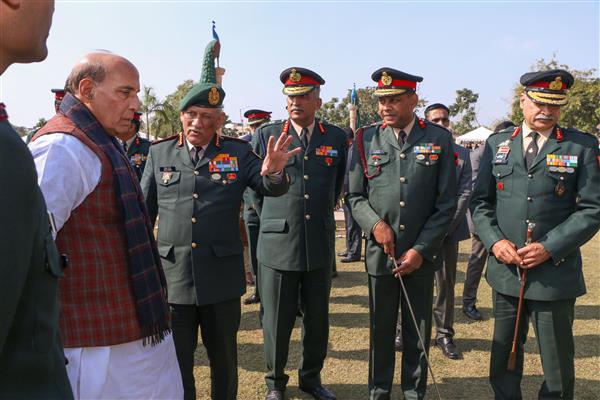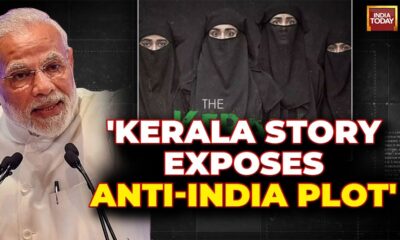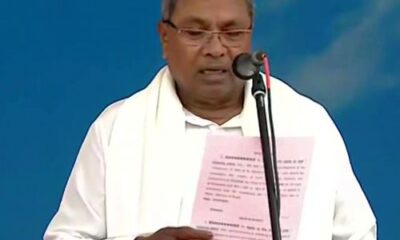National
The Third Eye: National security strategy need not be made public in its entirety
New Delhi, April 14 (IANS) The demand for a declared National Security Strategy (NSS) is rightly a matter of public debate and open analysis by strategic experts.
It has to be realised, however, that not all aspects of the strategy of handling national security could be openly announced for the very reason of confidentiality of the information on the country’s threat scenario which is at the base of responses required to be put in place under that strategy at any given point of time.
The security scenario has a large variable component in today’s world and it is accepted that the life of long-range security assessments itself had generally been shortened.
There is open agreement on a number of initiatives that are to be taken to serve the cause of national security such as promotion of public education that is designed to spread an awareness among the citizens that they all have a contribution to make for safeguarding national security in a democratic dispensation where the state considered itself responsible for the security of people as well.
The validity of many publicly known concepts like ‘national security being inseparable from economic security’, the threat to cyber security and cyber data running through the lifelines of the country and open warfare giving way to ‘proxy wars’ in this new era where the instrumentality of ‘terrorism’ was in full use in the latter, is now well established and this had created new paradigms for framing the national security strategy.
Many components of this strategy — both in terms of the inputs on which it was formulated and the appropriate responses it deemed necessary — would have to be treated as ‘protected information’ to be kept from the prying eyes of the adversary.
An evaluation of who the ‘friends and enemies’ are in the present and for the future, would itself be an assessment that the government would like to keep to itself notwithstanding the stand that might be taken by it in public — for reasons of being politically correct.
National security is rooted in a combination of defence capabilities, a strong security set up anchored on competent national Intelligence agencies and the total ‘national power’ attributable to a developed economy providing for a strong national infrastructure, utilisation of demographic dividend and free trade agreements with other major countries.
In the sphere of defence, details of import of military equipment preferably with a provision for its manufacture in India on suitable terms and conditions, may become known but the pattern of its deployment will remain a confidential part of whatever would be made public in the name of India’s national security strategy.
Defence plans are conditioned by military intelligence, including signal intelligence, that was by its very nature a secret. The critical national infrastructure is run on cyber systems which involve creating a robust and confidential cyber security framework.
Demographic situation is relevant to the broader issue of national security in the sense that it determines the potential strength of the country for the future.
Two-third of India’s population is below 35 years and this gives this country a strategic advantage over China that has an aging population. The NSS may declare plans of how the country would rally the youth for serving the cause of national security.
Finally, since economic security would be strengthened by the success achieved by diplomacy in working out trade pacts with other friendly and economically strong countries, the crucial role of diplomatic power in enhancing national security on that count alone, should find a prominent mention in the NSS.
The macro aspects of national security are by and large in the public domain and these all would figure in a declared NSS for giving a suitable message to the international community about India’s political will to safeguard its national interests and also for instilling confidence among the people of India that the regime was well attuned to handling any threats to national security.
Today’s national security set up evolved over a period — particularly since the ‘Kargil war’ that had resulted from Pakistan’s attempt to surreptitiously infiltrate army personnel with Islamic militants on the high mountains of Ladakh and occupy a couple of peaks in Drass sector in May 1999 — ought to be defined in the NSS document.
The functions of national intelligence agencies, including Intelligence Bureau, Research and Analysis Wing, and National Technical Research Organisation, can be broadly explained and also the supporting National Security Council Secretariat (NSCS) headed by National Security Advisor (NSA), presented in some detail.
NSCS had the responsibility of ensuring that threats to national security were constantly studied and analysed and the framework of coordinated responses to deal with them was laid down — covering the spheres of military, internal governance and diplomacy.
National security is an integral concept that mandates an ongoing coordination among the civilian, technical and military intelligence agencies. While the NSA plays a crucial role in the formulation of security policy, he is also the final arbiter on the issues of intelligence coordination.
In the Indian context, NSA is the member secretary of the NSC which was placed under the PMO in 2002 and also is the head of the NSCS as already mentioned. He performs three major strategic functions. In the Nuclear Command Authority the Prime Minister chairs the Political Council (PC) for according political sanction while the Executive Council headed by NSA makes operational assessments that helped the PC in decision making — the Strategic Forces Command headed by a Commander-in-Chief would execute the decisions on the ground.
With the threat to cyber security gaining significance, India has established a National Information Board (NIB) which is chaired by the NSA for formulating the National Cyber Security Policy, ensuring information security and handling the threat of ‘information warfare’.
A Centre for Development of Advanced Computing has been created and a Cyber Emergency Response Team (CERT-IN) has also been established. Finally, a nine-member Defence Planning Committee (DPC) has been constituted under the chairmanship of the NSA in 2018 with senior representatives from the Ministry of Defence, External Affairs and Finance as members, to align strategic objectives, defence requirements and financial allocation.
The DPC is also responsible for policy and strategy, capability development, defence diplomacy, defence production and creation of a manufacturing ecosystem. The institution of NSA is thus the kingpin of the system that ensures an integral look at national security and a coordinated response from various wings of the government to the security scenario existing at any given point of time.
The demand for declaration of a NSS has been voiced in many circles — many freelance strategic analysts have been pressing for it in particular — but the issue here basically is one of understanding the reality that there was a difference between publicly announcing the defence and security infrastructure built up by the country and not letting the adversaries know what counter-measures India is envisaging to deal with them.
The spectrum of hostile forces facing the nation itself was not static and the rise of the era of ‘proxy wars’ had further added to the importance of intelligence which was, by definition, information gathered and kept confidentially.
NSS outlines the country’s security objectives and the ways to be adopted to achieve the same.
In the areas of defence, international relations and counter-intelligence measures, the country’s policies and systemic build up could be made public and they would become the declared components of NSS at the macro level in a formal strategy document.
The framework of response to covert threats to security is on a different footing as it would have to be kept outside the public domain for the reason that it is based on intelligence or ‘protected information’.
In the sphere of defence, India finalised its Defence Acquisition Policy (DAP) in 2020 and the Defence Minister Rajnath Singh went on record to say that the DAP derived its ethos and spirit from the clarion call of an ‘Aatmanirbhar Bharat’ and ‘Make in India’, and aimed at ensuring that contemporary technology-based equipment is made available to the services in a time-bound fashion for modernising our Defence Forces.
It gives special attention to ‘Ease of doing business’ to encourage foreign investors to set up manufacturing entities in the defence industrial corridors provided by India.
DAP strives for achieving ‘Self Reliance’ rooted in indigenisation and innovation supported by strategic partnerships.
In the area of foreign policy India has made it clear that it believed in a multipolar world order, that it opted for bilateral or multilateral friendships based on mutual security and economic interests without prejudice to world peace and that it was willing to assert its voice as a major power on the issues of war and peace as well as human development.
As part of measures to safeguard its internal security, India has fiercely denounced terrorism in all its forms from all international forums and called for international cooperation to combat terrorism, drug trade and covert cross border offensives.
It is a matter of great satisfaction that India has taken an independent stand on Ukraine-Russia military confrontation and Israel-Hamas conflict — the two biggest events affecting the geopolitics of our times — and come out on top as far as the handling of international relations was concerned. All of this defines the National Security Strategy of India through action rather than words.
(The writer is a former Director of the Intelligence Bureau. Views are personal)
–IANS
dcpathak/khz
National
Defence Ministry: Year 2025 will be year of reforms

On Wednesday, the Defence Ministry announced that 2025 will be designated as the “Year of Reforms,” with a primary focus on establishing integrated theatre commands to enhance collaboration among the three branches of the military.
These reforms are aimed at transforming the armed forces into a technologically advanced, combat-ready force capable of executing multi-domain integrated operations, the ministry stated.
The initiative will emphasize emerging domains such as cyber and space, alongside cutting-edge technologies like artificial intelligence, machine learning, hypersonics, and robotics.
Defence Minister Rajnath Singh described the “Year of Reforms” as a pivotal milestone in the modernization of the armed forces.
“It will set the stage for significant advancements in the nation’s defense capabilities, ensuring the security and sovereignty of India in the face of 21st-century challenges,” he said.
National
A 3.2 magnitude tremor struck Gujarat’s Kutch district on Wednesday morning

A 3.2 magnitude tremor struck Gujarat’s Kutch district on Wednesday morning, according to the Institute of Seismological Research (ISR).
The district administration reported no casualties or property damage following the quake.
The tremor occurred at 10:24 am, with its epicenter located 23 kilometers north-northeast (NNE) of Bhachau, as per the Gandhinagar-based ISR.
Last month, the region experienced four seismic events exceeding a magnitude of 3, including a 3.2 magnitude tremor just three days ago, with its epicenter also near Bhachau.
Earlier tremors in the area included a 3.7 magnitude earthquake on December 23 and a 3.2 magnitude event on December 7, according to ISR reports.
Kutch was also jolted by a 4.0 magnitude earthquake on November 18, 2024. On November 15, a 4.2 magnitude quake hit Patan in north Gujarat, based on ISR data.
Gujarat is considered a high-risk earthquake zone, having experienced nine major earthquakes over the past 200 years, according to the Gujarat State Disaster Management Authority (GSDMA). The 2001 earthquake in Kutch, which occurred on January 26, was the third-largest and second-most destructive in India in the last two centuries, according to the GSDMA.
National
Diljit Dosanjh faces legal action over concert songs

Singer and actor Diljit Dosanjh’s much-anticipated New Year’s Eve concert in Ludhiana faced legal hurdles after a complaint was filed by Punditrao Dharenavar, an assistant professor from Chandigarh.
Following the complaint, the Deputy Director of the Women and Child Department, Government of Punjab, issued a formal notice to Ludhiana’s District Commissioner, urging them to prohibit Dosanjh from performing specific songs during his live show on December 31, 2024.
The notice specifically targets songs accused of promoting alcohol, including Patiala Peg, 5 Tara Theke, and Case (Jeeb Vicho Feem Labbiya), even if the lyrics are slightly modified. The complaint points to previous warnings issued to Dosanjh by various commissions advising against performing these controversial tracks.
Despite these warnings, the singer allegedly continues to perform the songs with minor alterations. Dharenavar raised serious concerns about the influence of such music on young audiences, especially when minors are present at live events.
Adding to the controversy, Dharenavar referenced a 2019 Punjab and Haryana High Court ruling, which directed law enforcement to ensure that songs promoting alcohol, drugs, or violence are not played at public events, including concerts. This ruling underscores the legal basis for the complaint and has further intensified the scrutiny surrounding the event.
National
UP Minister’s convoy overturns, 5 person injured

Five people sustained injuries when a vehicle in the convoy of Uttar Pradesh Minister and Nishad Party chief Sanjay Nishad overturned into a ditch near Januan village in the Khejuri Police Station area of Ballia district late last night.
Sanjay Nishad shared details of the incident, stating that the accident injured five party workers, including four women.
“I was traveling with the convoy to participate in the Constitutional Rights Yatra organized by the party on Tuesday night. Near Januan village in the Khejuri area, one of the vehicles following the convoy lost control while trying to avoid an animal and overturned into a ditch,” Nishad explained.
The injured individuals have been identified as Rakesh Nishad, Ramrati, Usha, Geeta, and Iravati Nishad.
Senior police and administrative officials quickly arrived at the scene following the incident to oversee the situation.
National
Suchir Balaji’s mother alleges Murder


The mother of Suchir Balaji, a 26-year-old former OpenAI researcher found dead after accusing the company of copyright violations, has alleged that her son was “murdered” and called for a Federal Bureau of Investigation (FBI) probe.
Poornima Rao, Suchir’s mother, claimed her son’s death was a “cold-blooded murder” that authorities wrongly ruled as suicide. She further disclosed that a private autopsy report conflicted with the findings of the initial police investigation.
Rao alleged that her son’s apartment had been “ransacked” and cited evidence of a struggle in the bathroom, including bloodstains that suggested he had been assaulted.
“We hired a private investigator and conducted a second autopsy to uncover the truth. The private autopsy does not confirm the cause of death stated by the police. Suchir’s apartment was ransacked, there were signs of a struggle in the bathroom, and it appears he was hit based on blood spots. This is a cold-blooded murder being misclassified as a suicide. Lobbying in San Francisco won’t deter us from seeking justice. We demand an FBI investigation,” Rao wrote on X.
Elon Musk reacted to Rao’s post, commenting, “This doesn’t seem like a suicide.”
Balaji was discovered dead in his San Francisco apartment months after accusing OpenAI of violating copyright laws during the development of ChatGPT, as reported by Fox News. Despite these claims, the San Francisco Police Department found no evidence of foul play and ruled the death a suicide.
On October 24, shortly before his death, Balaji voiced doubts about the “fair use” defense in generative artificial intelligence. “I recently participated in a NYT story about fair use and generative AI, and why I’m skeptical ‘fair use’ would be a plausible defense for a lot of generative AI products,” he wrote on X.
-
Video2 years ago
PM Modi Attacks Congress in Karnataka with “Kerala Story”
-
Politics2 years ago
Siddaramaiah & DK Shivakumar sworn in as Chief Minister & Deputy CM respectively
-
Cricket2 years ago
CSK players rejoice 5th IPL title with their families (Pics)
-
Entertainment2 years ago
Karan Deol weds his longtime Girlfriend Drisha Acharya (Pics)
-
Sports7 years ago
History Of Official FIFA WORLD CUP Match balls
-
Entertainment2 years ago
Urvashi Rautela dazzles on Cannes 2023 red carpet (Pics)
-
India2 years ago
Ashwini Vaishnaw: Railway Board recommends CBI probe in the Odisha railway disaster
-
Entertainment2 years ago
Sunny Leone gets ready for Kennedy premiere in Cannes (Pics)



























